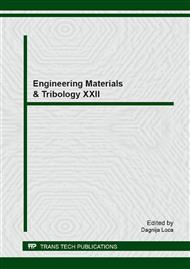p.59
p.63
p.67
p.71
p.75
p.79
p.83
p.87
p.93
Influence of Coal on the Wear Behavior of Steels in 3-Body Conditions
Abstract:
Abrasive and erosive properties of coal can lead to serious operational problems in mining industry. Here the abrasive medium is varied, containing often fractions of quartz, pyrite, and contents of coal which can be also mixed with water resulting in an abrasive slurry mixture. A better understanding of the dependence between the environmental and systematic conditions of the tribological processes that happen in ore mining and the wear behaviour of steels can be achieved only by analysing each parameter that forms these tribological processes. The Steel Wheel Abrasion Test (SWAT) represents a testing method which is capable of experimentally modelling the high stress wear environment typical for mining industry. The aim of this work exposes a comparison between the dry and slurry tribocontact in terms of wear, as well as the influence of coal simulating real field conditions.
Info:
Periodical:
Pages:
75-78
Citation:
Online since:
March 2014
Authors:
Price:
Сopyright:
© 2014 Trans Tech Publications Ltd. All Rights Reserved
Share:
Citation:


